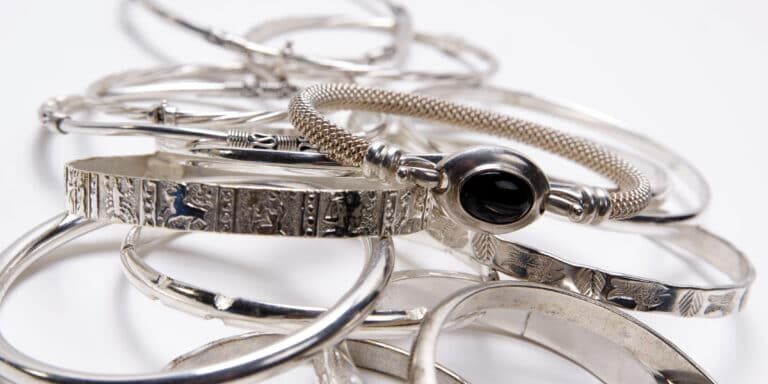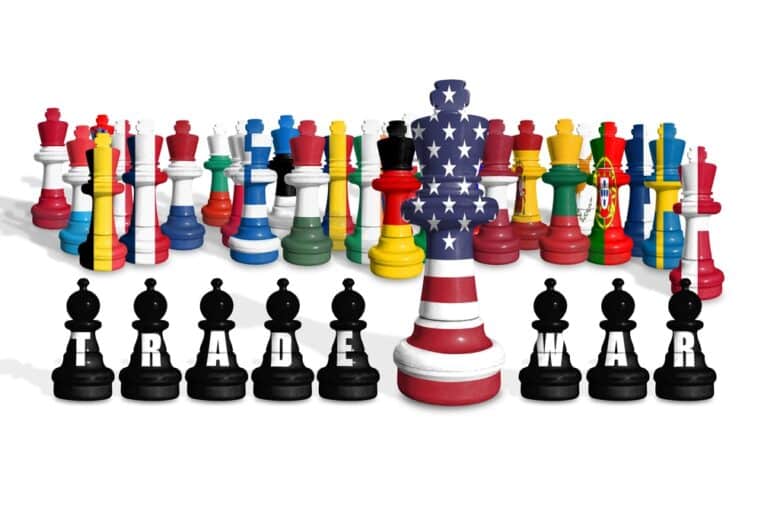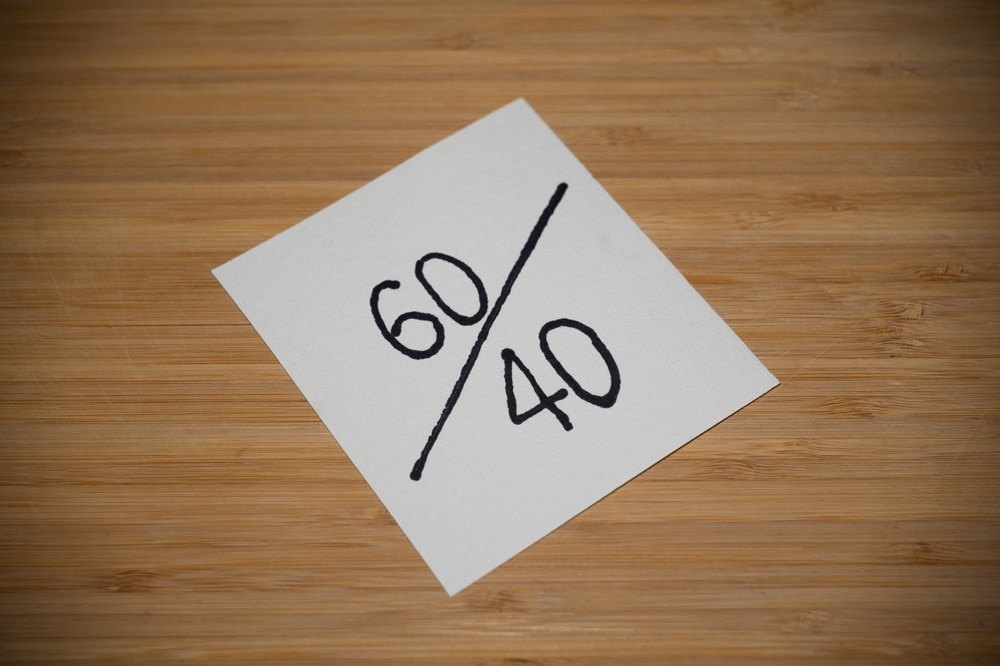
Sterling Silver Can Tarnish and Here’s How to Prevent It
The most important thing in avoiding silver tarnish is understanding what causes the chemical reaction. Sterling silver reacts with sulfates in the air and in many common materials that may be near your jewelry items. Air born sulfates exist everywhere but are particularly concentrated in industrial areas and coastal regions. Tap water and naturally occurring water both contain varying sulfate levels. Common household items such as papers, plastics, and cleaning products or beauty and body lotion products also contain sulfur compounds that will accelerate tarnish and make it hard to clean sterling silver.
Sterling silver is made of 92.5 percent pure silver and 7.5 percent alloy jewelry pieces. Copper is a favorite metal alloy for sterling silver jewelry although other metals are sometimes used. Sterling silver rings can be decorated with pure silver, but pure silver is typically too soft for large jewelry pieces. Chosen for its strength and beautiful sterling silver has a lifetime of durability. Pure silver is very soft, making it a poor choice for an everyday ring such as an engagement ring or a wedding band with gemstones made by a jeweler. The addition of copper makes sterling silver strong jewelry pieces. A sterling silver ring is typically marked with an engraving to inform consumers that it is a genuine precious metal. The number .925 is sometimes used to specify that metal is sterling percent silver.
Sterling silver rings can be polished with silver polish or coated in rhodium to become tarnish-resistant as part of jewelry care. Microfiber cloth is good to use to remove tarnish. Rhodium is a member of the platinum metal family and as a coating, it gives sterling silver jewelry a high-gloss finish. Storing sterling jewelry in a cloth pouch or individual compartment in a jewelry box is the best way to prevent scratching. Bleach, ammonia, and chlorine and other harsh chemicals can damage or discolor sterling silver rings.
Hairsprays, shampoos, lotions, and perfumes are all laden with sulfates. The airborne particulates or residue on your hands will tarnish silver. Do not store your silver in your bathroom or vanity area around makeup. Do not handle jewelry with makeup or lotion on your hands. And keep jewelry out of beauty and nail salons than are pungent with product fumes. Tissue paper, newspaper and many of those printed craft papers often use acid-based sulfur dyes. Don’t package your jewelry with these seemingly innocuous fillers.
Car, airplane, and machine diesel exhaust have a lot of sulfate particulates. Don’t store your metals in a garage or leave them in the trunk of your car. Rubber is also a problem. This ubiquitous material is processed with sulfur and has a concentrated residue that accumulates on its surface. Rubber seal, rubber bands, and some rubberized plastic solids will leach sulfur into the air. An airtight container is the best.
Popular leather cords and straps used in jewelry making are tanned just like all leathers, using sulfur-based acids. Store leather separately from your metals. Store leather necklaces with silver finding ends along with silver saver tabs to prevent blackening. That crinkly clear plastic used for food packaging, gift baskets, and other applications is full of sulfur. This plastic is often used to make a fold and seal baggie sold for the retail packaging hand tags. Fireplace smoke near your jewelry can be an issue and make sure that chimney smoke stays clear so smoke does not fill you home.

Storing valuable sterling silver items in a safe place can keep them from tarnishing.
Storage To Minimise Tarnishing
Make sure your storage system is helping to prevent tarnish rather than accelerating it. Crinkly plastic bags, as well as rubber or plastic bins such as Tupperware type containers, are very high in sulfates. If you are storing your sterling silver supplies in many common craft storage units you may actually be accelerating tarnish. Keep your sterling silver findings in an enclosed, dry space. It also helps to store sterling silver in an enclosed, dry space. It also helps to store it in anti-tarnish bags and add silver saver tabs of silicone packets to remove humidity and moisture from your storage space.
Printed newspaper, dyed tissue paper, and many types of aerosol products contain sulfates that will tarnish your sterling silver nearby. Remove these items from your studio space or a storage area. Sterling silver cleaning supplies are inexpensive, easy to use, and readily available. Keep a treated cleaning cloth within reach in your work area. A quick wipe will remove tarnish from most items. Anti-tarnish dip cleaners and other solutions are available according to your preference. Tarnish cleaning products are usually safe on most sterling silver items but can damage some stones and pearls.
Certain silver alloys are naturally less likely to tarnish than sterling silver. Argentium or TruSilver are silver alloys with a high tarnish resistance due to different chemical makeup. These alloys are considerably more expensive than silver sterling but they do offer extra protection against tarnishing. Some findings may also come with anti-tarnish treatments that will help delay the onset of tarnishing. Some common industry treatments include spray-on anti-tarnish treatment, flash plating, e-coating, or wax tub tumbling. These treatments vary in efficacy and durability and will increase in tarnish time when comparing across different silver items.
People usually appreciate tips for preventing silver tarnish and package inserts describing tarnish prevention and silver jewelry cleaning instructions. Men and women should make sure that jewelry is the last thing they put on before leaving the house. It should also be the first thing they take off when they return home before washing with soap, cooking, cleaning, or bathing. Do not wear sterling silver jewelry to nail salons, automotive service centers, or any locations with high levels of sulfate fumes.
It is important to remember that all sterling silver is not the same. Even when you store items under identical conditions you will find that pieces tarnish faster than others. You do not always know the history of the items before you received them. The time they spent on the shelf, their exposure to fumes in transit, and other variables may play a role before they arrive in your hands. Now we will discuss protecting cutlery, trays, and other sterling silver and their protection from being tarnished.
What is Tarnishing?
When someone says they’ve got silver sulfide on their sterling silverware it’s just a fancy way to say tarnish. Watch this video to understand silver tarnishing. Tarnish is the black film that develops on your sterling silver over time. You can’t wash tarnish off with soap and water since it is actually caused by a chemical reaction between the silver and sulfur, or sulfur-containing substances such as air, water, wool, felt and rubber for instance. The only way to remove tarnish is by polishing it off. However, you don’t want to polish silver very often for several reasons because when you polish silver it takes a little silver off. So you want to do it a maximum of 1-2 times per year.
Pure silver is an element and it is a soft metal. To make it even harder sterling silver which is 92.5% percent pure silver has another harder metal combined with it, typically copper, to make it harder. Since silver can easily get scratched or dented you have to handle it with care. That includes storing it so that items don’t bang into one another while they’re in storage.
Keep your sterling silver in an area without high humidity and out of high heat. Did you know that humid air and heat both hasten to tarnish? Therefore, make sure you’re storing your sterling silver in an area of your home that does not suffer from heat fluctuations and is also not too humid. A good storage place would be in a drawer in a hutch or china cabinet as opposed to a wet basement or hot attic. Not only is your china cabinet not too humid or hot it makes it convenient to access your sterling silver when you want to use them for special occasions.
Store your silver in flannel treated bags and cloth to help retard tarnishing. You should place your sterling silver in flannel bags or chests lined with flannel cloths. Such flannels have been treated with silver nitrate with help stop tarnishing. Several different types of storage containers are available. For sterling silver, you can choose either a bag with little slots to place the silver or a chest. There are also various sized bags that you can use for storing larger silver items like trays and bowls that you can use. Storing sterling silver in these treated flannel bags will not prevent you from having to polish your silver again but it will lessen the need for polishing because less tarnish will develop.
You want to make sure you don’t use acidic paper or newspaper because the inks and acids can pit, corrode, and damage your sterling silver. Don’t use wax silver for storing sterling silver items because then you have to remove the wax before using it for eating which is impractical. The only items to be suggested for waxing and are non-food items you wish you display in your home. In that case, once an item is polished and all tarnish removed waxing can prevent air and water from reacting with it and tarnishing it again as quickly. Of course, this wax can make your sterling silver look duller so you just may want to polish your display items periodically.

Sterling silver, also called. 925 silver, consists of 92.5 percent fine silver and 7.5 percent other metals.
Enjoying Your Sterling Silver
I want you to be able to enjoy your sterling silver items such as using them on special occasions along with your fine china and crystal. If you find you’re never using your silver consider decluttering it. Another reason though to use them often is because regular use is the best way for tarnish from forming. Make sure that you wash all items soon after use since the salt and acidic foods can cause damage and pitting and to dry them thoroughly before placing them back in their storage containers.
No matter how well you care for your sterling silver jewelry, dishes and cutlery they will naturally tarnish over time. While you can’t necessarily prevent tarnish from air and light exposure you can follow a cleaning guide. Wiping your sterling silver object with a microfiber cloth removes dust but fails to bring back the silver’s shine. To get rid of tarnish and prevent it from coming back use a targeted silver polish. Put a small amount of silver polish on a clean cloth, dampened if necessary. Rub the polish on your sterling silver item in an up-and-down motion, not circular to avoid highlighting fine scratches. Turn the cloth frequently so tarnish isn’t deposited back on your item. Rinse in warm water and buff with a clean, dry cloth to shine.
If you are out of polish try these homemade cleaners. For sterling silver that is dull, filmy, or not yet discolored mix a few drops of mild dish soap with warm water and dip in a soft cloth. Rub the sterling silver objects then rinse in cool water and buff with a cloth until dry. For heavier tarnish mix a paste of three parts baking soda to one part water. Wet the silver and apply the cleaner with a soft, lint-free cloth (not paper towels). Work the paste into crevices, turning the cloth as it gets dry. Then rinse and buff dry.
How to prevent tarnish? Natural tarnish may be unavoidable but there are some ways to make sure that your flatware, jewelry, and dishes don’t lose their sterling silver luster as quickly. Here are some tried and tested tips. Store each piece of sterling silver jewelry in its own anti-tarnish bag in a cool, dry spot. Put a piece of chalk in an anti-tarnish bag to help remove moisture from the air. Put jewelry on after perfume to prevent it from sticking to your sterling silver. Don’t be afraid to wear your sterling silver. Friction slows down tarnishing so the more you wear it the more it’ll shine.
The question is often asked, does sterling silver rust as well as tarnish? The answer is no. Sterling silver will never rust as that only occurs in metals that contain iron. Silver doesn’t and tends to be alloyed with copper. It will only tarnish.
Tarnish is a thin layer of corrosion on metals - a chemical reaction (oxidation to be exact) between metal and non-metal environmental elements containing gases like oxygen, hydrogen sulfate, and sulfur dioxide. Tarnish can appear on sterling silver as a dull, yellow, gray, or black film coating.
Thankfully, sterling silver tarnish is only a surface problem. Sterling silver does not rust which can eat away at all levels of a metal object silver tarnish only affects the top layers of the sterling silver object. Think of it as simple everyday wear with a black coating and you have the definition of sterling silver tarnishing. Pure silver is indeed tarnished resistant but is much too soft to be made into jewelry or other items for household use that sterling silver is used for. Since about the 1300s sterling silver jewelry, as well as household items, have been made using silver and other metals such as copper (for added strength) in a ration of 92.5 percent silver and 7.5 percent other metals known as .925 sterling silver. It’s the other metals, especially copper, which react to moisture and sulfur in the air and cause the tarnishing of your sterling silver objects.
We’ve now come back full circle to our original question. How long does it take for sterling silver to tarnish? As we’ve learned, the rate of how fast a sterling silver item tarnishes depends on many factors, not the least of which is the environment in which the silver item is stored.
Other factors include whether or not the silver item has been exposed to chlorine in swimming pools or household products like hairspray, hand lotion, or makeup. Additionally. Other factors are how much the sterling silver item is already tarnished and how long the silver item has been exposed to oxygen.
Tarnishing is also affected by the type of metal alloy used in addition to the sterling silver. In short, how long it takes for sterling silver to tarnish is dependent upon these factors and more. But, it’s safe to say that tarnishing can occur both quickly and over longer periods of time, months even, depending on the factors listed. One thing is certain, however, the color of the tarnish on the sterling silver item changes as the tarnishing deepens over time. This changing of colors is “thin-film interference” and can be simply defined as light “splitting” when it hits the thick layer of tarnish on the sterling silver object. In this phenomenon, some of the light reflects off the top layer while some light reflects off the silver beneath the tarnish.
There’s a certain science to tarnishing but to keep your sterling silver items shiny and in good shape just follow the instructions listed so far. Then, you can be sure that your beloved sterling silver family heirlooms and sterling silver jewelry can be passed down to another generation to be enjoyed for many years to come.











